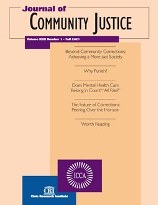Complete Issue
Author: Don Evans.
Source: Volume 25, Number 04, Summer 2016 , pp.1-28(28)

< previous article |return to table of contents
Abstract:
The three articles in this issue of JCC discuss day reporting centers, the concentration effects of parolee residence and community violence, and the benefits of arts programming,and specifically dance, as a rehabilitative tool in prison. “A Day in the Life of a DayReporting Center” by Elaine Gunnison and Jacqueline B. Helfgott provides a very informative and thoughtful analysis of the value of day reporting centers. They point out that the scarcity of empirical research has made it difficult for day reporting centers to produce evidence to funders and to the public that this form of programming is worth continued support. The fact, they note, that these programs can provide intensive supervision together with intensive service delivery offers the best chance at a positive outcome for clients. They also focus on the value of a needs-based approach to supervision that assists desistance from crime. In exploring the needs of the day reporting center’s clients in their study, they note that the clients had a range of needs at intake and that the ranking of the importance of these needs revealed similarities and differences across gender and race. Generally speaking, the clients had a positive programming experience, but despite this, some clients still had unresolved critical needs that must be met to ensure a successful reentry. This type of research in community corrections is desperately needed, and it would be a positive sign if more can be done to improve data keeping and to replicate studies such as this one. The challenge of supervising parolees in the community has become more difficult and will continue to be so as we enter an era of mass supervision. In “Concentration Effects of Reentering Parolees and Community Violence,” Dr. Joseph F. Pascarella highlights the concentration effects of parolee residence and community violence. He discusses the issue of parolees being released into areas of high crime and violence with little or no infrastructural support. His analysis tests the concentration of effects to determine the level of parolee concentration and its association with high rates of violence and notes the impact on recidivism and future offending. This is an informative article and should lead to similar investigations that could have an impact on where we locate reentry services. In “Exploring Dance Programs in Prison” Amy Sheppard and Rose Ricciardelli explore how dance programming offered in prison settings can contribute to desisting from crime within the context of reintegration. The authors examine the possible benefits of arts-based programs offered in North American and U.K. prisons. They also explore the impact of life in prison on the body and the potential for dance programming to resemble rehabilitative programs. They argue that the benefits of dance programming and experiences are connected to notions of desistance from crime and suggest that this type of program can be used in prisons to further rehabilitative ends.Keywords: Day reporting center (DRC), intermediate sanctions, Community Center for Alternative Programs (CCAP), offender needs, recidivism; arts-based programming; parolee residence and concentration effects
Affiliations:
1: Journal Editor.